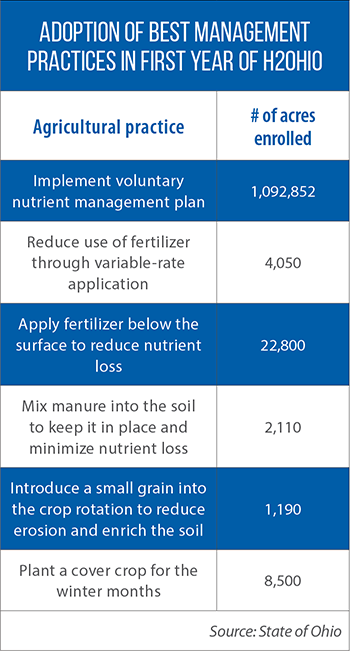More than 1 million acres enrolled in Ohio program that incentivizes farmers to help protect water quality
In early 2021, payments began going out to Ohio farmers participating in that state’s most ambitious effort to date to protect the state’s waterways from nutrient pollution.
“We know the problem took years to create, and we are cognizant that it will take years to fix,” says Joy Mulinex, director of the Lake Erie Commission, which serves as a forum for collaborations between the state’s departments of Agriculture and Natural Resources and the Ohio Environmental Protection Agency.
H2Ohio was first introduced in 2019 by Gov. Mike DeWine, and received an initial legislative appropriation of $172 million. In his proposed budget for the coming biennium, DeWine calls for spending $242 million on the program. Part of that money goes to a range of incentive payments for farmers — anywhere from $2 per acre for developing a voluntary nutrient management plan, to $60 per acre for using manure applications that meet state standards. These and other science-based, cost-efficient management practices (see table) were identified prior to the start of H2Ohio; the key to the program’s success is now getting enough acres enrolled in the voluntary program.
The à la carte program allows farmers to pick management practices that best fit their land for up to three years of funding. Last year, 1,815 farmers enrolled 1,092,852 acres. That amount of acreage is approximately 44 percent of cropland in the program’s target area: 14 counties in the western Lake Erie basin’s Maumee River watershed.
“I feel good about what we are doing,” Mulinex says. “We always want more to happen, faster, but a lot of credit goes to the Department of Agriculture in identifying and incentivizing the best management practices, but also to the producers who really stepped up to enroll their land. “Commodity groups also get credit for encouraging their members to participate.”
Other advances over the past year include funding the creation, restoration or enhancement of 5,500 acres of wetlands, as well as agreements with individual farmers to install 681 structures that improve drainage water management. And for producers in the 27 counties in the Lake Erie watershed, the Department of Natural Resources is offering a one-time, $2,000 per acre payment to enroll land in the U.S. Department of Agriculture’s Lake Erie Conservation Reserve Program.
To ensure these new investments are working, the Ohio Environmental Protection Agency will conduct nutrient studies on 72 percent of Ohio’s watersheds every two years, using data from 2016 and 2018 as the baseline.
The recently enacted HB 7 is another tool for monitoring and managing the H2Ohio plan, says John Patterson, who sponsored that legislation last year as a member of the Ohio House. That measure became law in early January; it directs the Department of Agriculture to categorize watersheds and appoint planning and management coordinators in each of Ohio’s seven watershed regions. These coordinators will identify sources and areas of water quality impairment, including the impacts of phosphorus and nitrogen nutrient loading. Also under HB 7, the Department of Agriculture can establish a pilot program in a single watershed that assists farmers, agricultural retailers, and soil and water conservation districts in reducing phosphorus.